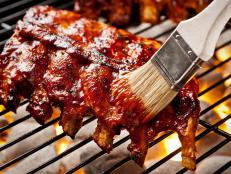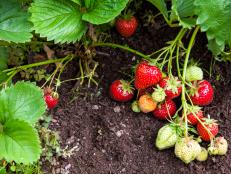Aisle-by-Aisle Summer Shopping
Heading to the supermarket with a shopping list is one thing, but leaving with what you need is another entirely. Yes, they stock charcoal; but should you buy briquettes or hardwood? Your buddy loves shrimp; do you get large or jumbo? For every summer essential, there seems to be a confusing variation — cilantro or parsley, whipping cream or heavy cream. Here, a cheat sheet to a half dozen shopping conundrums. Remember it the next time you hit the store and you'll come out a winner.

Fuse
Regular or Heavy-Duty Foil?
Regular Foil: Though your grandma may still call it tin foil, most of the metal sheets you buy are now made with aluminum, which is more durable and can be rolled thinner. Regular foil is handy in the kitchen for wrapping food and lining baking sheets, as well as offline tasks like making fishing lures, TV antennas, kids' jewelry and anything else you can think of.
Heavy-Duty Foil: Just as its name promises, this kitchen essential is extra-resilient. Use it to form pouches for grilling, wrap casseroles in the freezer, line roasting pans for quick cleanup, and tent poultry and pies to protect them from burning.
The bottom line: There are many stand-ins for plain old "thin" foil, but when a job calls for the heavy stuff, you pretty much have one option. Stock up on a roll for summer.

Jason Smith, Unspecified
Charcoal Briquettes or Lump Charcoal?
Charcoal Briquettes: This backyard staple (aka "regular" charcoal) is made of sawdust, charcoal, limestone, borax and other additives that have been bound together into factory-made bricks. Their uniform shape and chemical makeup allow them burn steadily, evenly and for a long time — a plus for cooks who hate to replenish coals midway through grilling slow-cooking cuts like leg of lamb.
Lump Charcoal: Also called "natural hardwood," these craggy nuggets are formed from hickory, cherry, mesquite and similar woods that have been burned at high heat to remove moisture. Fans say they're easier to ignite and that they burn "cleaner," lending a subtle smoky taste to food. They certainly burn hotter — making them great for searing (think steaks and burgers). The downside: Lump charcoal burns fast, so you have to replace it more often than conventional briquettes.
The bottom line: It's a matter of taste. Opt for charcoal briquettes if you want convenience. Go for lump charcoal if you're after an extra touch of flavor.

Renee Comet, 2013, Television Food Network, G.P. All Rights Reserved
Large Shrimp or Jumbo Shrimp?
Large Shrimp: Size is relative, especially when it comes to shrimp. One producer's "small" is another's "medium." The best way to compare is by the number of pieces per pound; the smaller the number, the bigger the shrimp. Most supermarkets sell large shrimp at 16 to 20 pieces per pound. Here's a tip: Almost all shrimp arrives on our shores frozen (except for wild-caught and domestic shrimp from the Gulf and other areas). What you see laid out on ice at the supermarket has simply been thawed. For peak freshness, opt for shrimp from the freezer case and thaw it at home the day you cook it.
Jumbo Shrimp: A larger, fancier — and pricier — option, jumbo shrimp come in at 10 to 15 pieces per pound. They're great for the grill, since you can skip the skewers and place them directly on the grates without fear they'll fall through.
The bottom line: If you're watching your budget, pick up large shrimp. If you're out to impress or following a recipe that requires a specific size — e.g., stuffed jumbo shrimp — go with the big boys. Look for stores that clearly label the more eco-friendly options.

YelenaYemchuk
Whipping Cream or Heavy Cream?
Whipping Cream: Milk fat is the rich, sweet stuff that gives cream its luscious silkiness and makes whole milk so much tastier than skim. By regulation, whipping cream must contain at least 30 percent and no more than 36 percent milk fat.
Heavy Cream: Even richer than whipping cream, heavy cream contains at least 36 percent milk fat. And more fat means it's easier to whip to soft, pillowy peaks. Plus, it will hold its shape longer.
The bottom line: Both whipping cream and heavy cream will enhance soups, sauces and baked goods. But if you're looking for the ultimate topper for your berry shortcake, seek out heavy cream.

hichako
Parsley or Cilantro?
Parsley: This mainstay of the supermarket herb section has dark green leaves, crisp, firm stems and a peppery bite that freshens dishes from around the world — think scampi, potato salad, meatloaf, chimichurri and tabbouleh. For the best bang for your buck, skip the mild curly-topped variety and go for the more-assertive flat-leaf (or Italian) parsley.
Cilantro: Its fans call it refreshing, pungent and magical. Detractors call it soapy. There are no neutral parties when it comes to this Anne Hathaway of the herb world. Also known as fresh coriander, it plays a starring role in Asian, Caribbean and Latin American cuisines, adding snap and brightness to everything from banh mi sandwiches to cilantro lime chicken. Unlike parsley's, cilantro's stems are sweet and soft and can be chopped up and eaten along with the fringed leaves.
The bottom line: Parsley and cilantro don't taste the same. To tell them apart, pinch a leaf and sniff: Parsley smells grassy, and cilantro smells flowery. Or look at the leaves: Flat-leaf parsley leaves are darker and thicker and have triangular points; cilantro leaves are lighter and thinner and have more-serrated, squared-off edges.

Coconut Water, Coconut Milk or Cream of Coconut?
Coconut Water: Quite simply, this is the liquid you find at the center of a young coconut when you drill a hole in the shell and stick in a straw (lounging under palm trees optional). Coconut water is thin, mild-flavored and loaded with electrolytes. Many marketers promote coconut water as a sports drink, though its benefits have yet to be fully studied.
Coconut Milk: This rich, flavorful (and fat-laden) staple of Southeast Asian curries is made from grated coconut meat that's been pureed with water and strained. Infinitely versatile, it's also a vegan favorite and makes a nice substitute for conventional cream in dishes like pureed soup or oatmeal. Be sure to shake the can vigorously before opening, to help distribute the thick cream that rises to the top.
Cream of Coconut: If you like pina coladas … chances are you've had this candy-like creation made from coconut puree and sugar. The old-school cocktail staple also gives coconut cream pies, flans and cakes their tooth-shattering sweetness.
The bottom line: Grab a can of coconut milk to keep on hand for curries and more. Buy coconut water and cream of coconut as your menu dictates. You can't substitute one for the others.
































